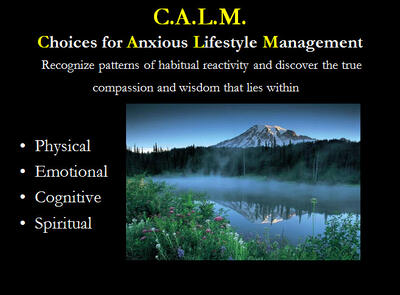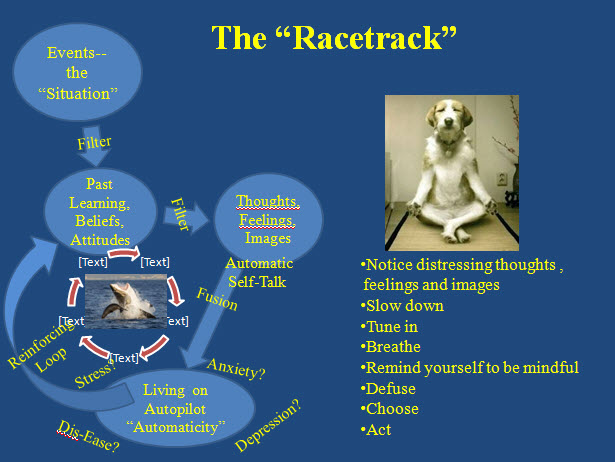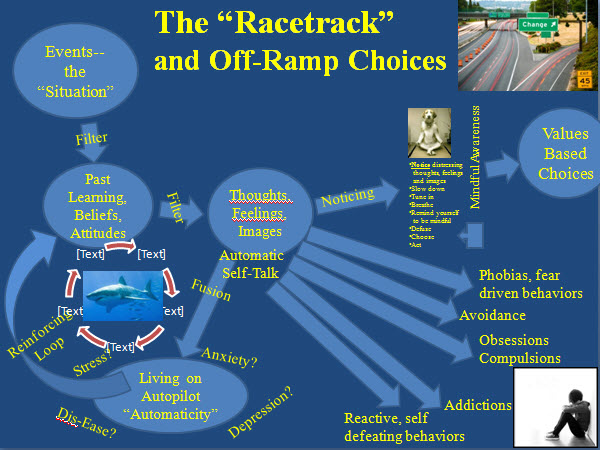
Choices for Anxious Lifestyle Management (C.A.L.M.)
Individual and group therapy for anxiety disorders since 1977.
If you suffer from severe anxiety, like forty million other Americans, you probably have a desperate desire to know why. You may think there is something terribly wrong with you physically. On the other hand, you may fear being seen as “mentally ill.” Many of our clients have kept quiet for years about their anxiety, experiencing increasing social isolation, self-doubt, and self-criticism. For all who struggle with anxiety problems, the two most pressing questions are: “Why Me?” and “How do I get better?”
We have answers to those questions. In both individual and group therapy we provide you with a step-by-step comprehensive approach to understanding and managing your stress and anxiety.
At this point, an example will illustrate what we mean by a comprehensive approach to treatment. The following case is typical of several clients we have seen over the past few years. The real name of the client is not used and confidentiality is protected by omission of any identifying information.
Carol’s life was increasingly constricted and filled with despair. She found herself so terrified and confused by her panic attacks that she was no longer able to focus on her work or relationships. The episodes seemed to come out of the blue, without warning. She responded to the attacks by becoming hypervigilant, afraid even to go to sleep, as she was sometimes awakened at night by terrifying sensations that had her believing she was dying. Day or night, attacks brought fear, heart palpitations, dizziness, and the constant dread of another attack. She was left exhausted and depressed, unable to enjoy even the simplest of past pleasures.
Finally, she had to seek help. Fortunately, her family physician was able to get her in right away due to a cancellation. Finding nothing obviously wrong, he nevertheless referred her to an internist for further tests. No physical basis was found for her symptoms. Her panic attacks could not be explained by possible medical problems such as hypoglycemia, hyperthyroidism, a calcium-magnesium deficiency, mital valve prolapse, or inner ear disturbances. Carol, now diagnosed as having panic disorder, was referred to our center fir specialized anxiety disorder treatment.
While every client is unique, there are also similarities. Carol seemed typical of so many clients that we have seen for panic disorder.
She was not very good at relaxing. Her breathing was shallow and rapid, especially while under increased stress. Even after initial introduction in diaphragmatic breathing, she still found it extremely difficult and needed a great deal of daily practice.
Other health behaviors needed improvement. Carol drank several cups of coffee daily, did not exercise, and did not get enough sleep. She rarely took vacations and considered relaxing a “waste of time.”
Carol’s self-talk was mercilessly negative and self-critical. The daughter of anxious parents, she had grown up in a home where she had learned harsh perfectionist beliefs. She had a long list of “shoulds” and “musts” that were impossible to live by. No matter what she did, it never seemed to be good enough.
Carol was also prone to something called “awfulizing and catastrophizing.” Her symptoms provoked terror based on her rear that she was about to die, go crazy, or have a heart attack. At the very moment she felt the first sign of rising anxiety, she engaged in “scare talk,” saying to herself, “What if I am going to die? I can’t stand this. It’s getting worse. It must stop.” Of course, her symptoms immediately got worse.
Carol was anxiety prone in still another way. Eager to please and fearful of disappointing or offending anyone, Carol was markedly nonassertive. Believing she must please everyone, all the time, left her either depressed because someone was critical of her or anxious that she might disappoint them. Moreover, her need to avoid conflict or disapproval led her to stuff and stack anger and resentments. Years of denying her feelings had provided ample fuel for an anxiety disorder.
Carol’s recovery program followed the comprehensive model described earlier. A summary of her recovery plan is as follows. Categories overlap.
Physical
Carol learned and practiced diaphragmatic breathing, deep relaxation, and visualization. She began regular aerobic exercise to reduce anxiety and give her a sense of personal power. Nutritional improvements included elimination of caffeine, eating a healthier diet, and taking vitamin supplements (B complex, C, Calcium-magnesium). Carol was offered medication by her family physician, but declined, preferring instead to develop her own resources.
Emotional/Interpersonal/Behavioral
Carol developed assertiveness skills and began expressing rather than suppressing feelings, particularly anger. She practiced talking about her emotions and wrote extensively in her journal. Carol learned that conflict avoidance and passivity were destructive not only to herself, but also to relationships. She learned verbal skills for dealing with conflict and for negotiating with others based upon a strong sense of personal rights.
Cognitive/Whole Self
Carol learned corrective self-talk, a process for recognizing and changing self-defeating beliefs. Changed beliefs allowed her to approach life in a more optimistic and relaxed manner. She was able to eliminate “scare talk” and purposely reduce rather than unconsciously intensify anxiety. A more accepting, nurturing view of self led to increased self-esteem and satisfaction with life.
Existential/Spiritual
With lowered anxiety, Carol began broadening her focus beyond work and her list of “shoulds” and “musts.” She began exploring her spirituality and developing interests based on her own unique beliefs and values, feeling free to pursue what seemed important to her. Supportive and calming self-talk allowed her to feel more free and expand her comfort zone. Life became more meaningful.
Your situation may differ from Carol’s. Your progress may be slower or faster. Through a comprehensive recovery program, together with hard work over a period of months, Carol was able to free herself from her panic disorder. Most important, she now has the skills to keep her anxiety from overwhelming her. Life is good now and Carol is able to enjoy it.
Our experience has shown us that a comprehensive approach, such as described in Carol’s case, is usually effective. An approach involving physician, therapist, and patient as treatment team members is ideal.
One last point. People recover. We have seen lots of recovery-but never without active involvement and practice. A major goal of the C.A.L.M. program is powerfully involving participants in their own recovery. You recover not by reading a book ort listening to a lecture, but by trying out and practicing new behaviors and ways of thinking. Take responsibility for your recovery. Do the work, make the changes, and practice those new skills and attitudes until they become part of you. You will not be disappointed.
We specialize in the treatment of stress and anxiety. We've devoted more than three decades to helping others gain freedom from worry, stress, and anxiety disorders. In most cases our work extends to life and wellness coaching, helping our clients not only manage their stress better but take their lives to a whole new level of well-being. In working with you, we will share what we've learned about what works in managing stress and anxiety, and becoming empowered to be the architect of your own life. Basically, effectively managing an anxious lifestyle and achieving well-being is about cultivating the discipline of mindful self-awareness leading to making healthy choices central in your life. The benefits of embarking on this journey extend far beyond anxiety and stress management.
Healthy choices are those choices that enhance your life by contributing to physical and emotional health, balance, effective management of stress, reduction of anxiety and depression, relationship satisfaction, and a sense you're on a path that's in alignment with you at your best. Our ten Life Choices cover a lot of ground and we believe mastery of all ten leads to an awesomely fulfilling life, mastery not limited to the management of stress and anxiety.
We will provide you with a step-by-step roadmap for expanding and sharpening your awareness, clarifying your intention, embracing healthy choices, strengthening your commitment and motivation, and following through with developing and living a powerfully compelling vision of high-level well-being and balance.
One of the most meaningful and powerful quotes we know comes from Rollo May, an American existential psychologist and the author of the influential book Love and Will:
"Real freedom is the ability to pause between stimulus and response, and in that pause--to choose!"
May used the term “real freedom” to indicate the ability to make choices that are clear, intentional, and freely chosen as opposed to the freedom we think we have. While we like to think that we are fully in charge of ourselves, we are often living out a script written in the past, responding in predetermined habitual ways, or simply reacting in a rather mindless or emotional way to whatever comes up. “Real freedom,” to use May’s expression, is about pausing mindfully, with full awareness and inner calm, and within that pause, making a conscious, intentional and emotionally intelligent choice, a choice more realistic and practical, and a choice that contributes to greater satisfaction and well-being. Our work is about coaching you to become masterful at consistently making those kinds of choices.
Stress, Anxiety, and Choices
The word "stress" is now so common place in our language that most people are quite surprised that it was hardly in our vocabulary at all prior to 1960. Now it's a household term much more common than yoga ormeditation.
Since World War II there has been a continuous increase in the drive to do more with less time, be more competitive, more productive, and put forth ever greater effort. Hans Selye, a Hungarian physiologist who coined the term stress, defined the term as the response of the body to any demand placed upon it to adapt. Today, a common meaning of the term stress, is in regard to the wear and tear on our bodies and our minds stemming from the tension created by the demands of modern life. By all measures, those demands, and therefore our difficulties with stress, have dramatically and steadily increased over the last several decades.
With increasing stress and the corresponding erosion of leisure time, there has been a dramatic shift toward unhealthy lifestyles. With that shift, there has also been a shift in how we get sick, and how we die.
There was a time when the leading causes of death were infectious diseases such as tuberculosis, typhoid, encephalitis, rubella, and polio, diseases that have largely been eradicated or controlled by medication and vaccines. Now, we are dying from lifestyle diseases stemming from unhealthy choices made over years or decades. To a large extent, unhealthy choices such as overeating, smoking, drinking, workaholism, sleep deprivation, and overall poor self-care are directly linked to stress. Additionally, it's now been well established that stress weakens the body’s physiology and immune systems, consequently exacerbating disease processes.
A common consequence of either acute or chronic stress is anxiety, derived from the Latin term anxius which denotes the "feeling of agitation and upset." Do you worry? Do you sometimes toss and turn at night rather than getting good sleep? Do you have a sense of dread? Do you have trouble letting go of things? Do you find yourself anticipating negative events, and not feeling confident at all about your ability to cope with those events? Do you find yourself getting anxious and fearful about being anxious and fearful? Do you find yourself unable to enjoy life because of worries and concerns that never leave you. Guess what – we're talking about anxiety, and anxiety disorders have become our most common psychological problems. We like the term dis-ease, a state that is anything but peaceful, a state characterized by worry, agitation, and dread.
Almost a third of the population of the United States will experience panic attacks during their lifetimes. According to the Anxiety Disorder Association of America, 40,000,000 Americans are presently dealing with an anxiety disorder. These people are as much as three times more likely to seek medical help, and six times more likely to be hospitalized for psychiatric treatment than people without anxiety. There are probably another 40-50,000,000 people who are simply "stressed-out."
Is it in their genes? Is it a chemical imbalance? Is it a medical condition? Our experience tells us most anxiety disorders are about life experiences and choices. To a large extent, people learn to be anxious and they learn coping mechanisms that actually prolong and exacerbate their anxiety.
People with chronic stress and anxiety have a lot of negative learning to overcome, often learning that can be traced back to their childhood. They have learned how to view unexpected events, conditions, and certain people as threatening. They've learned to doubt their ability to cope with stressful situations. They have learned to “awfulize” and “catastrophize,” expecting the worst. They have learned to think negatively about themselves and others. They are often out of touch with their needs and don't feel successful at getting their needs met. They often feel an inordinate amount of guilt, and they're prone to worry. They feel disconnected, and don't know how to be joyful. They're living in the past or the future, and have a tough time being fully present in the “here and now."
If any of this sounds familiar, rest assured there are solutions. As we stated initially, we're going to share everything we know about what works based on over three decades of clinical practice, and we will provide the assessment based coaching you need to more effectively manage your stress and anxiety.
Our work is about choices and mindfulness, two keys to overcoming debilitating stress and anxiety.
Anxiety Disorders that we treat
The following is a list of thirteen anxiety conditions with brief definitions.
Panic Attack: the sudden onset of intense apprehension, fearfulness, or terror. These feelings are often associated with impending doom. During these attacks, symptoms, such as shortness of breath, palpitations, chest pain or discomfort, choking or smothering sensations, feelings of unreality, or fear of losing control, are present.
Agoraphobia: anxiety about, or avoidance of, places or situations from which the escape might be difficult and/or embarrassing or in which help may not be available in the event of having a panic attack or overwhelming feelings of panic or panic-like symptoms.
Panic Disorder Without Agoraphobia: characterized by recurrent, unexpected panic attacks about which there is persistent concern.
Panic Disorder With Agoraphobia: characterized by both recurrent, unexpected panic attacks and agoraphobia.
Agoraphobia Without History of Panic Disorder: is recognized by the presence of agoraphobia and panic-like symptoms without a history of unexpected panic attacks.
Specific Phobia: characterized by “clinically significant” anxiety provoked by exposure to a specific feared object or situation, usually leading to avoidance behavior.
Social Phobia: characterized by “clinically significant” anxiety provoked by exposure to certain types of social or performance situations, often leading to avoidance behavior.
Obsessive Compulsive Disorder: characterized by obsessions that create marked anxiety, distress, and/or compulsions that are the efforts to neutralize the anxiety.
Post-traumatic Stress Disorder: the re-experiencing of an extremely traumatic event accompanied by symptoms of increased arousal and by avoidance of stimuli associated with the trauma.
Acute Stress Disorder: has recognizable symptoms similar to those of post-traumatic stress disorder, but occurs immediately in the aftermath of an extremely traumatic event.
Generalized Anxiety Disorder: characterized by at least six months of persistent and excessive anxiety and worry.
Anxiety Disorder Due to a General Medical Condition: characterized by prominent symptoms of anxiety that are judged to be a direct physiological consequence of a general medical condition.
Substance-Induced Anxiety Disorder: recognized by prominent symptoms of anxiety that are judged to be a direct physiological consequence of drug abuse, a medication, or toxin exposure.








